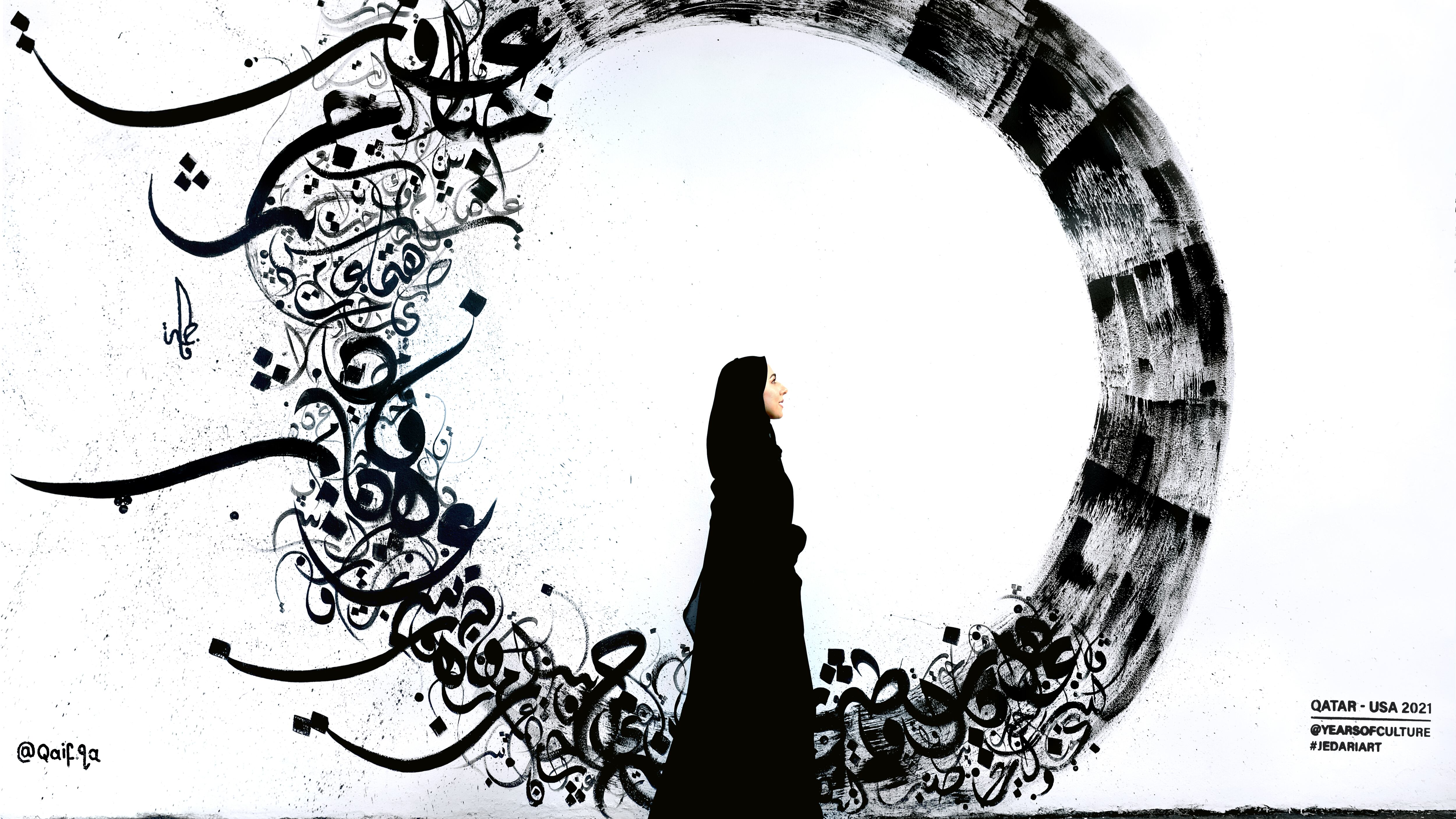“Because I have the passion for Arabic calligraphy, I feel that there is a relationship between myself and the letters. When I can’t write something, the letters are sad, because for a long time I did not talk to them,” says Fatima Al-Sharshani, the calligrapher behind Never Ending / Endless, a mural she recently installed at Southeast Alder Street and 11th Avenue.
Never Ending / Endless is Al-Sharshani’s third mural. The project comes to the Pacific Northwest by way of Portland Street Art Alliance, in collaboration with an overseas cultural exchange program from Qatar Museums’ Jedariart initiative—which helped recruit and select Al-Sharshani. Her mural is part of a larger project: 2021 Qatar-USA Year of Culture, which celebrates the relationship between the two nations.
Al-Sharshani paints in a loose white hijab and casual button-downs, both splattered in black pigment. Al-Sharshani balances a bucket of ink in one hand and brandishes textured brushes between stained fingers.
Within the finished composition, wide-bristled strokes loop dark like the stutter of static on an open canvas. Painted segments begin with a firm hand and tail softly into the next. Half the circle is connected by a staggering pulse, the heartbeat of its persistent revolution.
At one point along the circumference, trailing shadows burst into a cornucopia of letters and phonetics. Al-Sharshani chose to combine not words, but rather singular elements of the Arabic alphabet in the work, in order to create a sense of open interpretation. The symbols loop and swirl, as if caught in ecstatic dance. A torrent of eloquent possibility, Al-Sharshani’s meditative mural enthralls the viewer to imagine a story with infinite beginnings and endings.
Never Ending / Endless was written in the calligraphic style of Diwani. Al-Sharshani practices all of the calligraphic types, including Naskh and Thuluth (“the hardest one,” she says), but chose this font because “Diwani is all curves,” she explains. “It helped to express the endless continuity and infinity. The circle has no end, it is a deep, deep, deep cycle. I merged the circle with the Arabic letters, to give it depth, like the powers we all have inside of us.”
Al-Sharshani first wielded a bamboo nib just 10 years ago, after graduating from Qatar University. A lifelong appreciator of Arabic calligraphy, she enrolled in workshops at the Museum of Islamic Art in Doha, Qatar.
In its earliest origins, Arabic calligraphy was used to inscribe the Qur’an, and to represent the word of Allah. Fonts were sparse and largely utilitarian during the seventh century. Over millennia, complex artistic variants evolved, each with its own formal rules and styles. There are now seven to eight different forms of Arabic calligraphy, as well as countless interpretations of the classic forms. The art can be written on different mediums, with different inks, and even to different scales of shape and size.
Al-Sharshani spent the better part of seven years training for her mastery of each calligraphic style.
“A calligrapher must have strong letters,” she says. “I learned very well the classic rules and made my hand to be strong. Then I moved to the modern.”
When speaking, Al-Sharshani’s voice is potent with meaning. She remembers dedicating hours to classic poems with her chiseled pens in hand, before moving toward more expressive abstractions. In her experimentations with calligraphy, Al-Sharshani has written with her fingers, a quotidian mop, and even water upon a concrete floor.
Now, Al-Sharshani runs her own arts company, Qaif Calligraphy. She hosts workshops and creates commissions for clients in Qatar and beyond.
While working on the mural, Al-Sharshani was surprised and proud that a few Portlanders recognized the Arabic letters woven into her composition.
“My goal is for people to see the difficult beauty of Arabic calligraphy,” she says. For those who know Arabic, Al-Sharshani hopes that the individual letters will transform into words through their gaze. “I would like them to feel that the artwork talks to them, and for them to create their own story to this artwork.”
Even for those who do not know Al-Sharshani’s mother tongue, Never Ending / Endless may inspire a slow feeling of endless potential. Like the ouroboros, an ancient reminder of relentless yet rhythmic continuity, Al-Sharshani’s loop reiterates that time is long, and the cycles of life and death are inextricably linked as one.
